Click on a picture to enlarge it
| Snakes in Movies Group Pages |
All Movie Snakes Must Die! |
| All Movie Snakes Want to Kill You! |
| Dancing With Snakes |
| Giant Monster Snakes |
| Pet Snakes |
| Shooting Snakes |
| Snake Bites |
| Snake Charmers |
| Snake Face |
| Snake Fights |
| Snake People |
| Snake Pits |
| SnakeSexploitation |
| Snakes & Skulls |
| Snakes Run Amok |
| Snakes Used as Weapons |
| Snakes Used for Comedy |
| Snakes Used for Food or Medicine |
| Snakes Used Realistically |
| Throwing and Whipping Snakes |
| Kinds of Snakes |
| Rattlesnakes |
| Cobras |
| Black Mambas |
| Boas, Pythons, and Anacondas |
| Kingsnakes and Tricolor Snakes |
| Unusual Species
|
| Settings |
| Snake in the House! |
| Snakes in Beds |
| Snakes in
Jungles and Swamps |
| Snakes In Trees |
| Genres & Locations |
| Snakes In Westerns |
| Snakes in Asian Movies |
| Herps in Australian Movies |
| Herps in James Bond Movies |
| Herps in Silent Movies |
| Herps in Spielberg Movies |
| Snakes in Movies | ||
| Cleopatra (1934) | ||
| Spoiler Alert ! Some of these pictures and descriptions may give away plot details that you might not want to know before watching the film. |
||
 |
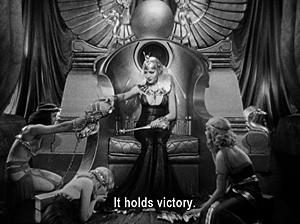 |
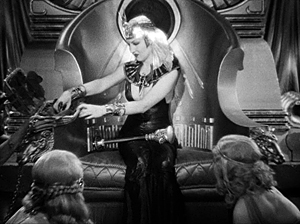 |
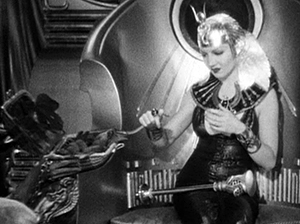 |
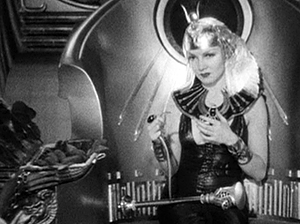 |
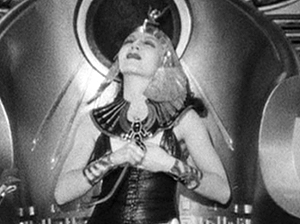 |
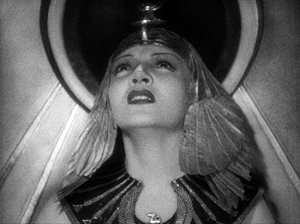 |
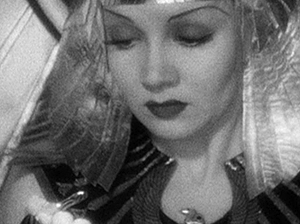 |
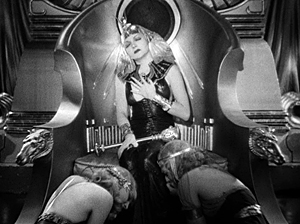 |
 |
 |
 |
| This is the best if cheesiest version of Cleopatra I've seen. Made just as the Production Code censorship was taking effect, it managed to throw in more sex and bare flesh than would be possible in American movies for another 30 years, and it became a huge box office smash that earned 5 Oscar nominations including best picture, winning one for best cinematography. Director Cecil B. DeMille wanted to popularize the story from Shakespeare's play, which he accomplished by making Cleopatra a sexy, man-hungry, femme fatale, and by using little dialogue, opulent sets and costumes, exciting and bloody battle scenes, and an evening of outrageous entertainment on Cleopatra's barge that includes scantily-clad (for 1934) women dragged out of the ocean in a fishing net offering shells full of precious jewels to Marc Antony, and a dozen cat-women dressed in leopard furs dominated by a man who tries to herd them with a whip. They fight him and and fight each other until eventually they turn cartwheels through flaming hoops. After all the fun, as the movie ends, Cleopatra (Claudette Colbert in a Cleopatra wig) finds Marc Antony dying from his own sword, so she decides to kill herself. As the Romans are battering down the door to her palace to take her to Rome for her execution, she tells her handmaiden Charmion that she is not going to Rome. She asks for "the basket" which she says "holds victory" then opens it. She takes out a small snake, briefly holds it to her breast, grimaces, then puts the snake back in the basket and locks it. (I would hire her as a snake room assistant.) That's it. She doesn't say what she's doing, or call the snake an asp. The audience is expected to know the details of her suicide. I can't make out what species of snake is used in the movie. If it came from a zoo it could be from anywhere in the world. But my guess, based on its striped pattern, is that it's a species of garter snake. Somebody has written this interesting item in the IMDB Trivia section which explains why the snake they used is so small - almost the size of one of Colbert's 1930s eyebrows: "When she first started having discussions with Cecil B. DeMille about playing the part of Cleopatra, Claudette Colbert expressed a lot of unease about her climactic scene with an asp, being terrified of snakes. On the day the scene was to be filmed, DeMille had one of the largest snakes sent over from Los Angeles Zoo and approached Colbert onset with it as she sat in costume on her throne. The actress was terrified and pleaded with him not to come any nearer to her with the enormous snake, whereupon DeMille produced the diminutive little asp and said "How about this instead?" Colbert was perfectly happy to film the scene with such a small snake instead." The scene is very brief in the movie, but In Shakespeare's play it's long and wordy. A "simple countryman" brings Cleopatra a basket full of figs that hides some venomous asps. She "applies" an asp to her breast, then another one to her arm. After she dies, her servant Charmian then applies an asp to herself. Then Caesar and some other Romans enter, find her corpse, and begin a forensic investigation befitting a TV crime drama in order to figure out how Cleopatra died. This is how the death scene begins in Shakespeare's play: "CLEOPATRA: Hast thou the pretty worm of Nilus there, That kills and pains not? CLOWN: Truly, I have him: but I would not be the party that should desire you to touch him, for his biting is immortal; those that do die of it do seldom or never recover. CLEOPATRA: Rememberest thou any that have died on't? Clown: Very many, men and women too. I heard of one of them no longer than yesterday: a very honest woman, but something given to lie; as a woman should not do, but in the way of honesty: how she died of the biting of it, what pain she felt: truly, she makes a very good report o' the worm; but he that will believe all that they say, shall never be saved by half that they do: but this is most fallible, the worm's an odd worm. CLEOPATRA: Get thee hence; farewell. CLOWN: I wish you all joy of the worm." |
||